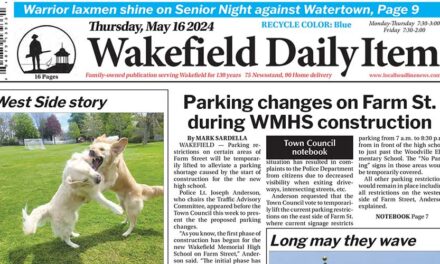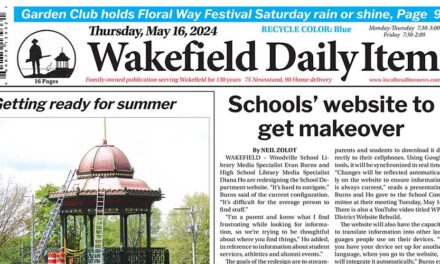Published in the September 26, 2017 edition.
By MARK SARDELLA
WAKEFIELD — Two more new initiatives designed to make Wakefield an even better place to live were presented last night to the Board of Selectmen. One focused on “streetscape improvements” in the downtown area. The other was a proposal to have the town designated as an “Age Friendly Community.”
Patricia Domigan, director of Municipal Services for engineering firm VHB, talked about steps that could be taken from the Lake to the Junction to improve connectivity, and make that corridor more vibrant and welcoming in order to draw people into the business district.
Domigan was joined by Mark Faverman, whose consulting firm was recently retained by the town to develop a branding and wayfinding design program for the downtown.
Domigan talked about pedestrian and bicycle connectivity between the Lake and the downtown.
She noted that the town is already working toward an identity as a cultural and arts center, pointing to the initiative to turn Albion Street into an arts corridor.
Domigan talked about measures that could make the downtown Main Street corridor more walkable, such as making it easier to cross Wakefield’s wide Main Street. She said that increasing the number of “bumpouts” at intersections could shorten the distance for street crossing. Looking at traffic signals was also a possibility.
She said that the plan would be to take a look at traffic circulation, noting that right now the downtown is “vehicular centered.” She said that some effort could be made to make the downtown more pedestrian and bike friendly. Promoting public transit use would also be a goal, she said.
She stressed that she was sensitive to the parking issues and was not proposing any reduction in existing parking, but areas could be set aside for things like food trucks and artist areas.
Faverman noted that any improvements would be done in a phased manner, as resources allow. He noted that his firm would be looking at community branding to incorporate with streetscape elements.
Domigan said that the timeline would be to evaluate and come up with recommendations over the next nine months with construction drawings ready for FY 2019.
Selectmen Tony Longo and Ed Dombroski said that they liked the aggressive timetable.
Selectman Brian Falvey asked about what could be done to prevent people from parking all day in prime downtown spaces. Domigan and Faverman said that enforcement, education and “moral suasion” could be effective in that area.
Dombroski said that he was “encouraged by the direction we are heading in.” He acknowledged that there had been studies done in years past and said that those studies are being used.
“Now we are at the point of action,” he said. “We are finally going to have a cohesive vision.”
Selectmen Chairman Paul DiNocco said that he wanted to make sure that business owners and downtown landlords were brought into the process at an early stage.
Board member Mehreen Butt stressed the importance of including the residents, especially families with kids, as the process moves forward.
Council on Aging Director Judy Luciano introduced Valerie Spain of the American Association of Retired Persons (AARP) to discuss the Age Friendly Community initiative. Luciano said that she and the Council on Aging were looking for the selectmen’s support as they enter into the network of Age Friendly Communities as designated by the AARP and the World Health Organization (WHO).
Spain told the selectmen that the Age Friendly Communities concept was started by WHO and the AARP then became an affiliate for the program in the United States. Spain explained that communities that apply under the program have two years to come up with an action plan. During that time, a community typically does assessments and conducts listening sessions. The Action Plan is then reviewed by the AARP’s national office.
She noted that Wakefield has done or is already doing a number of things that could be included in the action plan.
Spain said that about 25 percent of Massachusetts communities have applied to be Age Friendly Communities. She said that being designated an Age Friendly Community means that a community’s elected leadership has made the commitment to actively work toward making their town, city or county a great place for people of all ages.
Spain said that AARP’s participation in the program advances efforts to help people live easily and comfortably in their homes and communities as they age. It encourages older adults to take a more active role in their communities and have their voices heard. Initiatives focus on areas such as housing, caregiving, community engagement, volunteering, social inclusion and combating isolation among older citizens.
AARP works with local officials and partner organizations around the country to identify communities for membership in the Age-Friendly Network. AARP then facilitates the community’s enrollment and guides its representatives through the network’s implementation and assessment process.
Members of the AARP Network of Age-Friendly Communities become part of a global network of communities that are committed to giving their older residents the opportunity to live rewarding, productive and safe lives. Membership benefits include access to information and experts as well as public recognition for being designated an Age Friendly Community.
There is no cost associated with the program. The selectmen voted to endorse the effort to move forward with the process of becoming an Age Friendly Community.




